One question that surfaced several times in our recent discussion of tambour embroidery here on Needle ‘n Thread is whether or not you can combine tambour embroidery with other types of surface embroidery stitches in one project.
I’d say the point to remember whenever you’re pursuing any type of adventure in surface embroidery is that you aren’t bound by definite rules that say you can or can’t combine this technique or that technique. While tambour embroidery may be a specific technique that’s most often seen used in particular ways, there’s no reason why it can’t be combined with other techniques and used in any way you want to use it.
That’s the real fun of surface embroidery! There are so many variables, it never gets boring!
On that note, here’s the beginning of a little project that I’m using for further practice in tambour work.

Yes, that’s wool.
This particular wool is Fine d’Aubusson, a four-strand Merino wool made in France by La Route de la Laine for Au Ver a Soie. Many of the colors correspond with Au Ver a Soie’s range of stranded silk, and although the Fine d’Aubusson color range is not as extensive here in the States, I believe in Europe, especially in France, stitchers have access to a much broader color range. Here in the US, there are about 90 colors available.
The wool is colorfast. There are 8 meters per hank, but if you’re only using one strand from the four, that means there are 32 meters of stitchable wool in each hank.
Fine d’Aubusson is a really nice, fine wool for crewel work. I prefer it to Appleton – it’s not cranky like Appleton, it’s significantly less “hairy,” it has a slightly tighter twist than Appleton, and it’s quite easy to stitch with. It’s not as “soft” a wool as Heathway, Bella Lusso, or Renaissance Dyeing wools, all of which have a little more “boing” to them and a lot more of a soft spread. Fine d’Aubusson is a “firmer” wool, for lack of a better word, well-made and perfect for traditional crewel techniques.
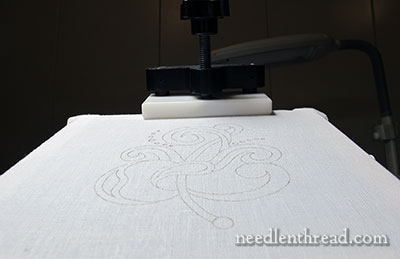
And this is the project that I’ll be using that wool on. The design is this Jacobean Leaf Variation.
I’m using linen for the ground fabric – specifically, a linen called Alabaster Angel by Legacy Linen. This is good stuff, and it’s a good surface for crewel work. Normally, I would use Alba Maxima by Legacy, but I had a piece of Alabaster Angel already cut, and I like both of them almost equally as well.
Legacy’s Alba Maxima is a great linen for general surface embroidery techniques, for crewel work, for goldwork, whitework, and so forth. In fact, it’s a just a great general all-purpose embroidery linen. They’re now producing it in a creamy color, too (not sure what the name is), so now there’s an option between white and an off-white, creamy version of the same linen.
The project is set up on stretcher bar frames – specifically, Evertite frames – and I’m using my Needlework System 4 table stand and frame clamp to hold it, so I can have both hands free for working with the tambour needle.
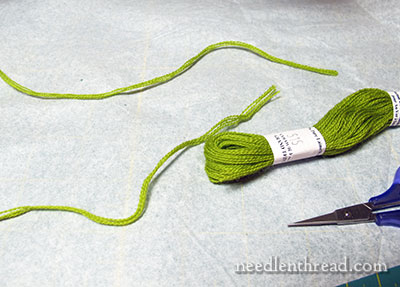
The wool is wound into these small hanks or skeins. Even though one of the speedy advantages of tambour embroidery is that you can work directly off a never-ending spool so you don’t have to change threads very often, in this case, I’m going to cut lengths of thread (about 20-22″) and separate the individual strands.

Now, since I’m still working my way through the learning curve with tambour embroidery (still practicing it regularly, still troubleshooting some variables and so forth), I knew that working with the wool would present some challenges and learning opportunities.
Well, right off the bat, with the first line of stitching, I learned something very valuable.
In the photo above, if you look at the chain stitch line coming down from the top of the photo, even though it isn’t super close, you can tell that the line is irregular, it looks awfully tight, it looks a little ratty, and it’s just not pretty. The little curved line at the base of the photo presents a chain stitch that is slightly better looking.
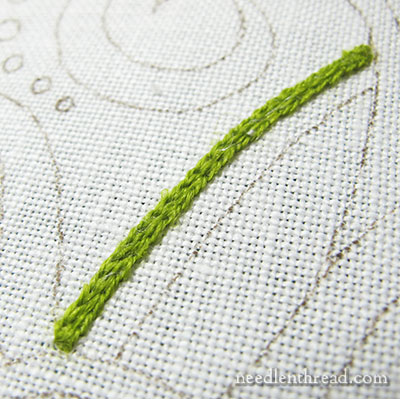
Here, you can see two lines that look somewhat tight and ratty!
Keep in mind that the stitch is traveling upwards in the photo in the line on the far left, and downwards on the line to the right.

So, my first couple lines of chain stitch in wool with the tambour needle were not so pretty, to say the least. As I was stitching, it was very difficult to pick up the thread without snagging the wool (which made the line look ratty) and getting the stitch through the fabric took care. The result was a couple lines of labored chain stitches that needed to be removed.
And this point supplies an opportunity I can’t pass up, to sing the praises of Good Linen. In the photo above, the arrows point to the area where I removed two rows of very tightly worked chain stitch in wool. After removing the thread, I ran the eye of the needle down the linen over the holes, and they disappeared. And the linen looks practically just as good as it did when I started.
You just can’t get a similar result when using inferior fabrics. Tearing out stitches takes its toll on flimsy fabrics. But on good linen, we could go around in circles for days, stitching and tearing out, with very little adverse effect on the fabric!
But who wants to do that?
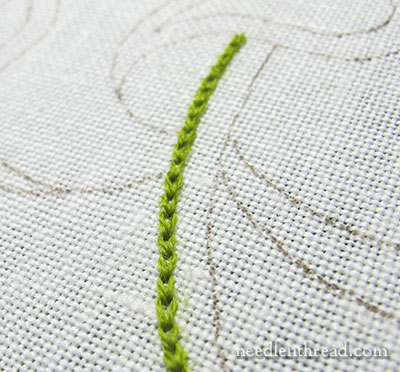
Ahhhh – and now we have a much better chain stitch. The stitches are plump, the thread is not snagged and messy – it looks the way it should look.
I didn’t switch to a regular crewel needle! But I did follow my own advice when it comes to trouble with crewel embroidery. Whenever anyone asks me how to solve thread problems of snagging, twisting, knotting when doing crewel work, I say switch to a bigger needle.
Often, we choose a needle that may “fit” with the thread and fabric in crewel work – the thread fits in the eye, the needle carries the thread through the fabric without any hang up – but strangely enough, if you go one size bigger (and sometimes two), you can usually eliminate all thread griefs in crewel embroidery. You are giving that wool more room to pass through the fabric with less abrasion.
Yes, you might think you’re embroidering with a railroad spike, the needle will seem so large! But as long as you aren’t leaving gaping holes in the fabric around your stitches, then go larger on the needle!
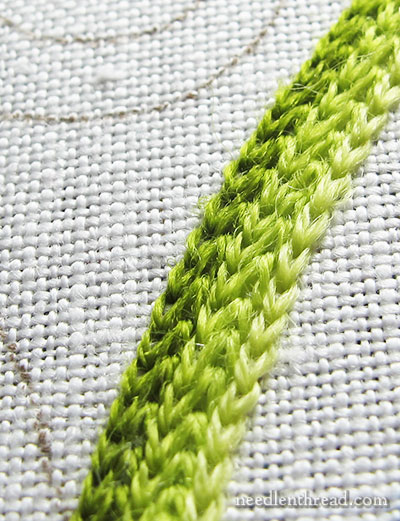
So I followed my own advice. While the size 110 (the largest size in the 3-hook set that comes with the tambour handle) seemed quite large enough to handle a fine thread, it just wasn’t doing the trick.
Foraging through my tambour supplies, I ferreted out a 130. It looked immense in comparison, but it did the trick.
The hook size made all the difference. And the stitching became easy, quick, painless.

These are my first forays into tambour stitching with wool thread. So far, I like it! After finishing the little sample above, though, I’ve concluded that working the chain stitches all in the same direction will produce a much smoother result. I’ll try that in the next space I fill.
The whole project will not be tambour work, though. I’ll combine some regular surface stitches in here as well, using the tambour needle wherever I want some chain stitch filling.
Really, the only advantage of using the tambour needle on chain stitch filling on this type of project is speed. You can definitely work the chain stitch filling faster with the tambour needle, even with cut threads and starting and ending each line.
Oh – well – there is One Other Advantage:
It’s fun!
Resources
You can find the threads and fabrics discussed in this article through locally owned needlework shops that carry goods from Access Commodities. If they don’t have it, you can always ask them to special order for you.
The fabric can be found online through Needle in a Haystack.
Different sized tambour needles and tambour hooks can be ordered through Lacis.
Evertite frames can be found through Needle in a Haystack.
In Canada, you can find the thread and fabrics through Traditional Stitches. In Europe, you can find the threads through Au Ver a Soie and shops that carry Au Ver a Soie products. I’m not sure about the linen. It’s probably named differently in Europe, and I don’t know who the distributor is. In Europe, you can find tambour handles and hooks through Brodely. They sell the handles in two separate sizes, in different types of wood. The largest hook they sell is a 120.







Wow – what a great, information-packed post! Thank you Mary! And those plumper chains look terrific!
Mary – thank you for this very interesting post – especially sharing how much the larger needle made a difference. I eagerly await further posts on your new tambour/surface embroidery project. It’s right up my alley!
Thanks!
Tomi Jane
Recently, I’ve been enjoying tambour bead embroidery. I’ve been using Clover’s version of a tambour hook, which they call the “Kantan Couture” Bead Embroidery Tool. It has a latch, so I rarely lose hold of the thread, as I do with a regular tambour hook.
Regarding combining techniques with tambour embroidery, last night I was beading a branch motif. For the long branches, I used the Clover tool because it is so fast. For the shorter branches, I used a regular beading needle because it’s simpler to use. From the front of the work, you can’t tell the difference!
Great article, thanks!
Great article, Mary. A larger needle does the trick many times. A small thing that makes a big difference. As for good linen, in any art our tools are important. Linen is one of the tools, medium, whatever one wants to call it; it makes all the difference.
Those wool threads are beautiful Mary, I like the colors you are using in this project, and I agree with you about “there’s no reason why it can’t be combined with other techniques and used in any way you want to use it”. I always put that in mind. Just waiting to see your tambour embroidery finish.
Dear Mary
I like fine Fine d’Aubusson wool thread and coupled with my favourite Alabaster Angel linen what more could you ask for when embroidering and you are right it is strong fabric the times I have pulled out thread stitches and gold work and all that tugging and pulling does not affect the linen I love it. I will wait in anticipation to see how the project progresses. I’ve just ordered some Tulle cotton fabric and a larger Tambour needle form Brodely, thanks for the resources on where to buy the materials it is so useful to know where to obtain accessories related to embroidery.
Regards Anita Simmance
THANK YOU for providing a link to a CANADIAN resource. I appreciate that very much since the only time I ever bought anything online it was from the US and shipping was $20.
G’day Mary,
Of very great interest. All set out and explained perfectly, and up to your usual high standard. Oh, oh, I feel a family saying coming on…About 40 years ago, An elderly friend, who was always putting his foot in his mouth (this time with a scone added), commented to his wife on the scones served for morning tea for a very proper straight laced lady who was visiting. “These scones aren’t up to your usual standard Pearly.” They were, of course, the visitor’s scones and poor long suffering Pearl wished a suitable incident, like the roof falling in, would occur to break the embarrassing silence and cause a distraction worthy of the gaff. So, “not up to you’re usual standard Pearly” has become a saying for all sorts of situations…
But not for any of your valued posts. This is all so very helpful and I appreciate the time and effort you put into sorting it all out and documenting it all so clearly for us. The how-to as well as the how-not-to really helps me see and understand what is happening. Thank you. Cheers, Kath.
LOL! I’m going to have to start using that line, Kath! Thanks for the grin!
Although I enjoy your posts no matter the topic, not all the techniques you discuss inspire me to immediately grab a needle and jump in. But from the very beginning of your exploration of tambour work a few weeks ago I’ve been hooked–no pun intended. I put a tambour needle and other needful supplies on my Christmas wishlist but now I’m not sure I can wait that long!
I have a question, and I hope I can get my thoughts across correctly. The curve starts at the bottom in a shallow curve, and winds itself up in a sharper curve to land into itself. This creates a dark abutting a dark. Did you end the thread when it abuts and/or begins from that join (for lack of a better word) or did you twist the next stitch to go immediately into the next row? It looks like you stop and start your threads, but I can’t tell for sure.
Thank you for bringing us all along to your ongoing tambour journeys!
Hi, Tracy! Yes, I end the line and start again whenever there is a sharp turn. Since I’m using a cut thread, it’s quite easy to do. On the last chain stitch in the first direction, I just pull the thread all the way through the chain, thread up a needle, and end the line the same way you would a regular chain stitch, with a small anchor stitch over the last look. Then, with the thread at the back of the fabric again, I start the next direction. -MC
Thanks again, Mary. You never cease to amaze me. Not only is your work drop-dead gorgeous, you aren’t afraid to admit you make mistakes and in my book that is a great virtue.
Have you ever used a punch needle (Igolochkoy)? In a weak moment I bought one of these but I have never been able to get the hang of using it, and I figure if you have used one, you will know how to do it and how to explain how to do it.
Wow so great loving everything that you have done cant wait to start on my own projects!!!
Thank you thank you thank you for all your posts on tambour embroidery! Your exploration of different methods and threads (plus your product recommendations and resource lists) have been invaluable as I prepare to take up the craft. Seriously, thank you.
One question: how many centimeters of embroidery would you say you get from a meter of thread? I know the width of the line must vary based on thread diameter, but I’m just curious whether one meter of thread becomes ten cm of straight stitching or what. I want to cover a lot of fabric (an 18th-century petticoat front and stomacher) and am trying to decide whether I can afford silk or wool, or should stick with plain cotton embroidery floss.
Thank you for any help you can give!
Hi, Heather – I’m afraid I’ve never actually measured it. I’m pretty sure you can get much more than ten cm of straight stitching from one meter of thread, though. But I suppose the best way to find out is to try it. It would depend, too, on the weight of the thread, the size of the stitches, and your stitching tension. Why don’t you try some cotton that you have on hand and see how it works out? Measure a meter and just start stitching – see how far you can go! If I have time, I’ll try it – but it’ll be at least two weeks from now before I can.
Hi
What count linen do you use? Very inspiring post and I can’t wait to have a try!
Alabaster Angel is a 48 count linen. But you don’t have to use an even-weave linen for this type of technique. A plain weave linen works fine.